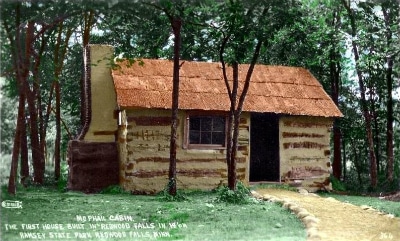The land that is Redwood Falls today was opened up to settlement in 1864, two years after the U.S.-Dakota War. Prior to the War, the Mdewakanton Dakota had been moved to a reservation along the Minnesota River, the Lower Sioux Agency being just a few miles southeast of the city's location today. Some of the Dakota people had tried to adopt the ways of the whites, such as farming, but many held to their traditions. Wild game had become very scarce on the reservation land and the Government had arranged for payments to help supplement the needs of the Mdewakanton Dakota on the reservation. In 1862, the payment due in April did not arrive until August 29th, a day after the War had begun. This delay of payment, along with abuses by the traders on the reservation, led to a revolt in which the Mdewakanton band joined other Dakota bands resulting in hundreds of settlers being killed and others taken captive by the Dakotas' along the Minnesota River from New Ulm to the Dakota border.

Colonel Sam McPhail had first come to what is now Redwood Falls while leading troops following the War. McPhail came to Redwood Falls on May 2, 1864, with a small party and immediately began work on a cabin and stockade. This first cabin was built from logs salvaged from buildings on the reservation; it was also lined with bricks on the inside for added protection. The stockade was an eight foot high reinforced wall of sod surrounded by a four foot deep ditch. There is no record of the stockade ever being attacked.
McPhail was born May 2nd, 1826 in Russellville, Logan County, Kentucky. He attended a military school in his youth and later participated in the Mexican War. Besides Redwood Falls, McPhail also founded the cities of Caledonia and Brownville, and was also an early land owner of Beaver Falls. McPhail, the pioneer who operated our first newspaper-The Redwood Falls Patriot (from 1866-1869), was the first judge of probate, first road supervisor, and first county attorney. He also funded the county for its first two years of organization.
John St. George Honner joined McPhail in the stockade later in 1864 with his family. He took land north of Redwood Falls (in what he would later plat as North Redwood) near the Redwood River in the Minnesota River Valley in 1865; in 1880 the township would be named for him. In 1869, he built a large home near the bottom of the Redwood Falls-North Redwood hill. This house (which is today listed on the National Register of Historic Places) was so large it served as an early boarding house and also at one time housed the first cheese factory of the area.
Honner, born May 21, 1831, in New York was also an important "first" pioneer; he was one of the first county commissioners, the first Register of Deeds, the first Assessor, first postmaster, and first president of the Redwood County Agricultural Association which operated the fair. As a politician, Honner served as a State Representative in 1866 and 1871, and also as a Senator from 1873-1874.
Honner also ran a leading RedwoodCounty business called the North Redwood Granite Works. This was the first quarry in the county, which in the early years made mainly paving blocks for city streets, including St. Paul's. Thomas Hosken was a stone cutter from Cornwall, England who joined the firm in 1886, turning production to monument work. The North Redwood Granite Works created the Friendly Indian Monument on the Morton hill, the Lake Shetek Monument, J.S.G. Honner's gravestone in the Redwood Falls Cemetery, as well as several monuments marking key locations of the U.S.-Dakota War for C.D. Gilfillan's Minnesota Valley Historical Society.
Although several railroads were planned through Redwood Falls at various times, only one actually succeeded. The Minnesota Valley Railroad made its first commercial run in 1878. The Minneapolis and St. Louis Railroad came through North Redwood in 1884.
Richard W. Sears, the founder of the Sears and Roebuck Company, was the first depot agent for North Redwood. The story of the birth of Sears and Roebuck begins with a Redwood Falls jeweler refusing an order of watches he claimed never to have ordered. Sears got permission to sell these watches to other agents and soon learned that the mail order business could be profitable. He quit the railroad shortly thereafter and set up in Minneapolis as a watch business. In 1887 he took watch repairman Alvah R. Roebuck on as a partner, moved the business to Chicago and put out a mail order catalog. Sears and Roebuck became a multi-million dollar business by the turn of the century, and a billion dollar business by the 1960s.
A.C. Burmeister is the father of electricity in Redwood Falls. Born in Hille, Germany on April 9th, 1861, he emigrated to the United States in 1877, learned the milling trade, and came to Redwood Falls in 1889. Shortly after arriving, he bought the mill, and later installed the first electric light system in 1898. In 1903, he dammed the Redwood River for more power and created Lake Redwood. Burmeister brought 24 hour light and power to the city around 1910.
Listed on the National Register of Historic Places in Redwood Falls.

